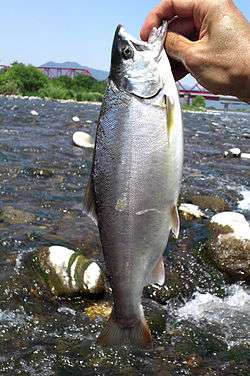Oncorhynchus masou
Oncorhynchus masou, known as the masu salmon, masu, or the cherry hybrid salmon,[1][2] is a species of salmon found in the northern part of the Pacific Ocean along East Asia, ranging from the Kamchatka, Kuril Islands, Sakhalin, and Primorsky Krai south through Korea, Taiwan, and Japan. A number of subspecies are known, including the anadromous, widespread masu Oncorhynchus masou masou (e.g. in Korea, Japan), the critically endangered, landlocked Taiwanese or Formosan salmon Oncorhynchus masou formosanus found in certain freshwater systems of Taiwan, the Biwa trout endemic of Lake Biwa, and the anadromous or stream-dwelling amago Oncorhynchus masou macrostomus restricted to western Japan.
| Oncorhynchus masou | |
|---|---|
 | |
| Juvenile Oncorhynchus masou | |
| Scientific classification | |
| Kingdom: | Animalia |
| Phylum: | Chordata |
| Class: | Actinopterygii |
| Order: | Salmoniformes |
| Family: | Salmonidae |
| Genus: | Oncorhynchus |
| Species: | O. masou |
| Binomial name | |
| Oncorhynchus masou (Brevoort, 1856) | |
On average, this salmon prefers a temperate climate, around the area of 65-58°N, and in the sea, it prefers a depth range of 0–200 m (0–656 ft).
Appearance

A masu salmon which has reached sexual maturity has a darkened back, and the stripes on the body sides become bright red with crimson tinge to merge on the abdomen into one common longitudinal band of lighter color. For this reason, it was given the name cherry salmon.
As adults, masu salmon tend to weigh 2.0 to 2.5 kg (4.4 to 5.5 lb) and measure roughly 50 cm (20 in) in length.[3] The maximum size that can be attained by this species (which is in the region of Primorsky Krai) is 71 cm (28 in) long and 9 kg (20 lb) in weight.
Lifecycle
Like other Pacific salmon, its lifecycle is subdivided into marine and freshwater periods; in rivers, this species lives from 1 to 3 years and can form living freshwater forms. The sea lifecycle, depending on the age of the young, continues for 2.0 to 3.5 years. In the sea, the masu salmon feeds intensely on crustaceans, less often on young fish. On attaining sexual maturity, in its third to seventh years of life, it enters rivers to spawn. Its spawning run starts earlier than that of other salmon species.
After spawning, most passing fish die, and those that remain alive (preferentially dwarf males) participate in spawning the next year, too. Emerging from the nest, the young do not travel to the sea immediately, but remain in spawning areas, in the upper reaches of rivers, and on shallows with weak currents. The young move to pools and rolls of the river core to feed on chironomid, stone fly, and may fly larvae, and on airborne insects. The masu salmon travels to the ocean in its second, or occasionally even third year of life.
Economic importance
This salmon, like most others, is a highly commercial species caught in fisheries, raised for aquaculture, and sought after as a game fish. It is marketed fresh and frozen and is often eaten broiled or baked.
Subspecies and morphs

- O. m. masou - masu salmon: anadromous (sea-run) form
- O. m. ishikawae (synonym) - "yamame", a nonanadromous, black-spotted form[4] (or a synonym of O. m. macrostomus, red-spotted)
- Iwame trout (recessive spotless morph, O. m. var. "iwame")
- O. m. rhodurus - Biwa trout, in Lake Biwa of western Japan
- O. m. macrostomus - amago, red-spotted masu salmon; endemic to western Japan
- O. m. formosanus - Formosan land-locked salmon
References
- "Oncorhynchus masou". Integrated Taxonomic Information System. Retrieved 15 January 2015.
- Froese, Rainer and Pauly, Daniel, eds. (2014). "Oncorhynchus masou_masou" in FishBase. April 2014 version.
- Augerot, X., Atlas of Pacific Salmon, University of California Press, 2005.
- Kato, F. (1991) Life histories of masu and amago salmon (Oncorhynchus masou and Oncorhynchus rhodurus) In: Groot, C., Margolis, L.: Pacific Salmon Life Histories, UBC Press. Vancouver. pp. 449–520.

